30 of the Best Podcast Microphones (For Any Budget)

Whether you’re brand new to starting a podcast, or a veteran podcaster, you should understand the importance of sound quality and investing in a good podcast microphone. However, there are so many podcast microphones out there at various price points — does it make sense to buy a $700 mic when maybe a $100 microphone will do for the podcast you’re producing?
On the surface, podcasts have a low barrier of entry and anyone can get started for free. Well, yes, technically all you need to internet connection and a pair of headphones with a mic. That said, because there are so many podcasts out there, listeners can lose interest quickly and if your sound quality isn’t crisp, they’ll go somewhere else. There’s essentially a zero tolerance policy for podcasts that don’t meet or surpass expectations, you often only get one chance. A decent microphone is the first, and easiest, way to improve you podcast’s sound.
Table of Contents
Popular podcast microphones
| Blue Yeti | Rode Procaster | Shure SM7B | SL300 | Audio-Technica ATR2100 | |
| Cost | $ | $$ | $$$ | $$ | $ |
| USB or XLR | Both | XLR | XLR | USB | Both |
| Link | See more | See more | See more | See more | See more |
It’s vital to have an understanding of the podcast mic landscape, have an idea of the features, pros/cons, reviews from other podcasters, USB microphone or can work with an XML mic, and ultimately weigh what kind of investment you’d like to make for your mic. How important is sound quality to your podcast and how much are you willing to invest in a top-notch podcast mic? You’ll also want to understand the podcast accessories you may or may not need to optimize your recording such as a pop filter, mixer, splitter, and others.
I’ve spoken with several podcasters out there about the advantages and disadvantages of several microphones and they all helped created this list. While other write-ups out there focus on mics as a general category, the microphones listed below are specifically made (and marketed) for podcasters. While it’s true most podcasters prefer a USB mic — the Blue Yeti seems to be the resounding favorite — XML mics are targeted more at studios.
Related reading: podcast equipment, podcast headphones, USB mixers, podcast hosting services, How to Start a Podcast
Podcast Recording Things to Consider
As I mentioned above, there are a few things you need to consider when investing in a new microphone.
Podcast Format
What kind of podcast are you recording? Will you be the sole speaker, or will you need a hook-up for multiple microphones? If you do have multiple speakers, will it be all the time or rarely?
Do you have a dedicated podcast recording studio or will you predominately be traveling and recording on the road? Mobility will be a major factor in what kind of mic, and mic setup, you’ll be needing.
Podcast Recording Equipment and Accessories
Will you need a pop filter or will the mic you’re purchasing have one already? Pop filters are the mesh screens that help even out your sound.
Will you need a USB mixer? More than likely. Mixers will be vital in your podcast editing process.
Should you get a mic stand? That’ll depend on the mic you ultimately choose, but if it’s not included you’ll want to get one. Nothing’s worse than having to hold or prop up a mic without a stand while you record your podcast. Homemade stands can also effect the sound since the mic won’t be suspended in the air.
Read more: essential podcast equipment
Features of Podcast Microphones
What kind of microphone hook-up are you looking for, USB or XML? If you’re new to podcasting, I recommend sticking with a USB microphone. USB mics are extremely easy to get started on your computer, with little or no software required.
Should you buy a dynamics or condenser microphone? Some consider this a preference decision. Dynamic microphones typically provide a more vibrant sound with a more casual feel, and condenser microphones are usually more clear but can pick up ambient noise as well.
Best Podcast Microphones
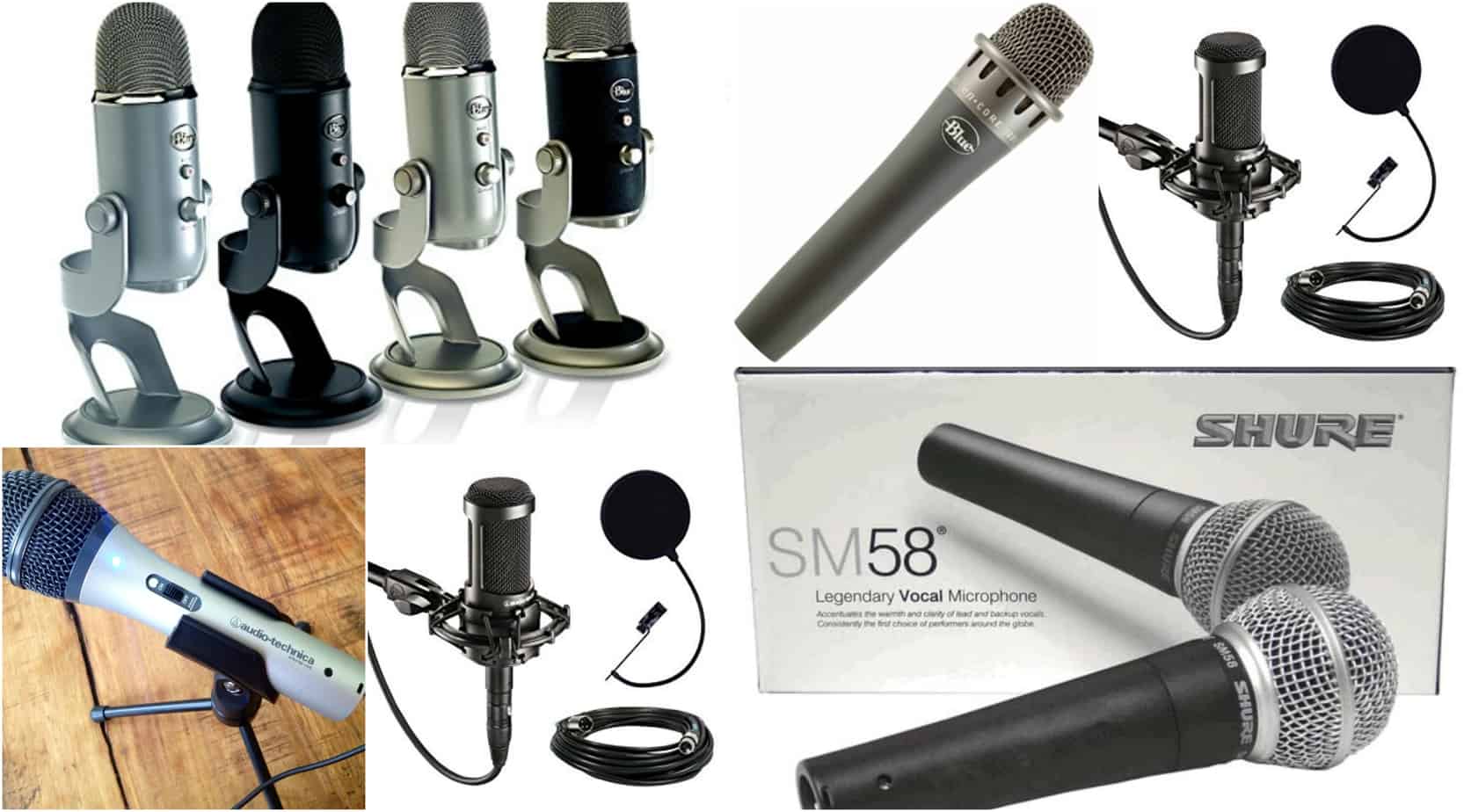
1. Blue Yeti USB Condenser Microphone
$
USB or XLR: USB and XLR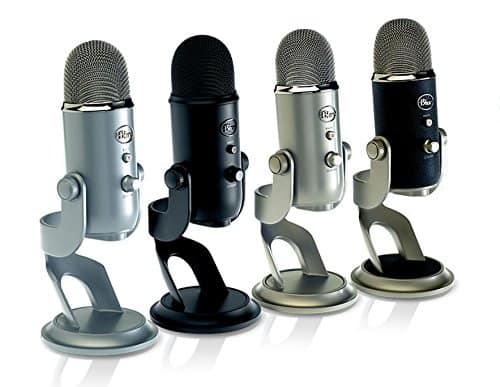
Features: Three different condenser capsules in one allows you to record in a variety of situations. Four different polar patterns will cater to your tastes. Multiple pattern selection: cardioid (heart shaped), stereo (overlapping circles), bidirectional and omnidirectional.
Integrated headphone amp and jack for real time monitoring with no delay.
Review: One of the easiest, and most popular microphones for podcasting. A quality mic for a reasonable amount. USB output for plug and play directly into the computer as well as XLR cable output for use with higher-end analogue equipment.
The Blue Yeti tends to be the most popular starter mic for podcasters.
2. Audio-Technica ATR2100-USB Cardioid Dynamics USB/XLR
$
USB or XLR: USB and XLR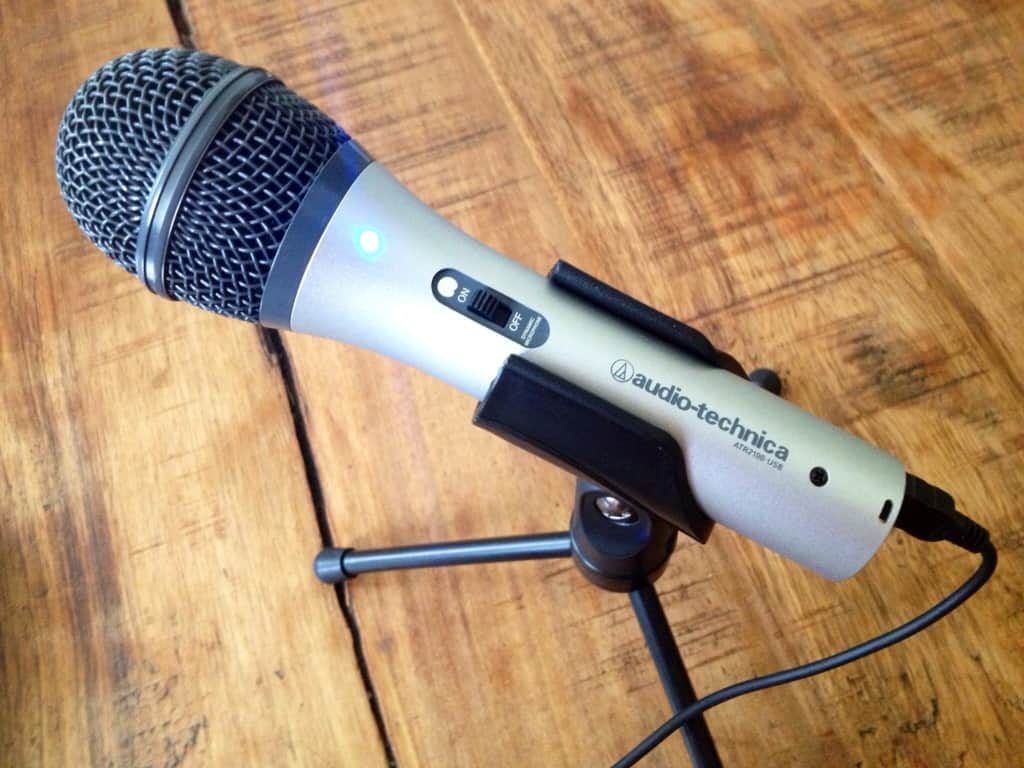
Features: A built-in headphone jack makes it easy to listen back to the mic’s output without any delay. The ATR2100 also has a quality analog-to-digital converter for excellent fidelity, and a headphone output with level control for monitoring.
Review: A cardioid (heart shaped) polar range eliminates unwanted background noise from behind and the sides, making this an affordable mic that’s suited for podcasting and/or recording acoustic instruments. Because it’s a dynamic mic, you’re not expecting plenty of warmth, but has the clarity you’re looking for.
3. Shure SM58-LC Cardioid Dynamic Vocal Microphone
$$
USB or XLR: XLR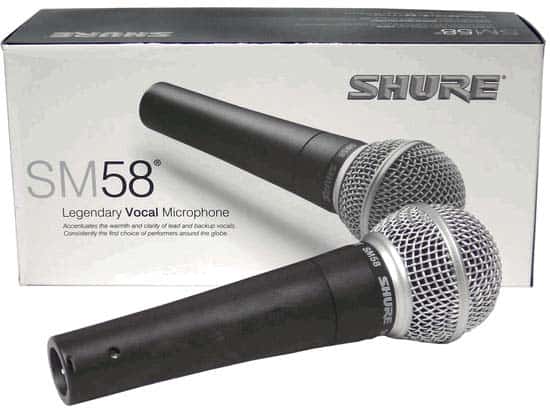
Features: Once labeled the “most popular mic in the world”, the Shure SM58-LC earned fame on stages worldwide. However, recent improvements have helped it cater to studios and podcasters alike. Dynamic vocal microphone suited for live vocals and studio applications.
Frequency response of 50 Hz to 15k Hz with enhanced midrange and bass rolloff.
Review: In our use, the Shure SM580-LC has a great low end sound, good warmth, smooth high-end, and overall just excellent quality for the price.
4. Audio-Technica AT2035 Large Diaphragm Studio Condenser Microphone
$$
USB or XLR: XLR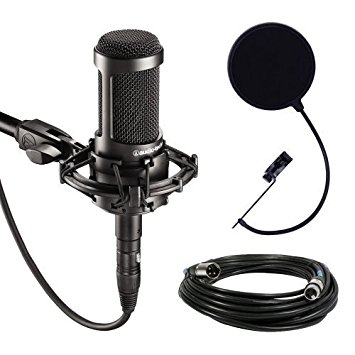
Features: As the name suggests, the large diaphragm allows this mic to be multi-functional while delivering low noise and exceptional detail and clarity.
Some specs:
- 80 Hz high-pass filter
- 10 dB pad filter eliminates unwanted low end rumble
- Cardioid polar pattern reduces pickup of sounds from the sides and rear, improving isolation of desired sound source
- Large diaphragm for smooth, natural sound and low noise
- Pop filter included
Review: A high SPL rating (Sound Pressure Level) and wide dynamic range make this mic suitable for recording a broad variety of different instruments and sound sources at high volumes.
5. Blue Encore 100i
$
USB or XLR: XLR
Features: Another high SPL handling mic capable of handling a variety of situations. If your podcast often features multiple guests, music, or other sound effects you may want to look at this microphone.
Review: Though typically used for stage and live performances, this mic has risen in popularity among podcasters due to the relatively low price point and decent quality for capturing voice recordings.
6. Rode Procaster
$$$
USB or XLR: XLR
Features:
Nearly every feature of this mic is made for voice recording. It’s designed to be great sounding while reducing all ambient noises. Here are the listed features:
- Broadcast sound quality
- High output dynamic capsule
- Balanced, low impedance output
- Internal shock mounting of capsule for low handling noise
- Internal pop-filter to reduce plosives
- Robust, all metal construction
- Designed and manufactured in Australia
- Includes RM2 stand mount, 3/8 inch adaptor, ZP1 zip pouch
Review: This mic was made for podcasting, simple as that. It has an internal pop filter to increase the clarity and reduce the noise of vocal broadcasts. Though these podcast-specific features do come at a price, every podcaster I’ve spoken to who uses the Procraster raves about it.
7. Heil PR-40 Dynamic Studio Recording Microphone
$$$
USB or XLR: XLR
Features: Another dynamic mic made for versatility. With custom magnet metals housed in a matte finish steel body with dual mesh screens, this microphone will outperform nearly every condenser mic in a comparable price range.
The shock-mounted diaphragm contains an internal breath blaster for an excellent response to the entire vocal range without any pops or hiss.
Review: Top of the line podcasting microphone with radio broadcast quality — averaging a 4.2 rating on Amazon. An extremely wide dynamic range with a flat response from 28 Hz to 18k Hz, making this microphone ideal for vocals, drums, as well as cabinet recording (guitars and bass) and more.
8. Blue Snowball iCE Condenser Microphone, Cardioid
$
USB or XLR: USB
Features: Custom condenser capsule provides crystal clear audio for real time chatting (Skype, Google HangOut etc), podcasts, voiceovers and vocals.
Listed features:
- Improve audio quality on Skype, Twitch and FaceTime
- Add crystal clear audio to recordings for YouTube
- Create podcasts and add narration to your home movies
- Record instruments or vocals
- Easy plug and play directly to your Mac or PC—no drivers to install
Review: Ease-of-use is the draw here. You simply plug this into your computer and it’s up and running without having to install any drivers. As easy to use as a mouse or QWERTY keyboard (both Mac and PC). Obviously with the low price point, you’re not going to get the quality of some of the upper tier mics, but mark this one down as a solid bang for your buck.
9. Samson Go Mic Portable USB Condenser Microphone
$
USB or XLR: USB
Features: Cardioid polar pattern for clear recording close up (interviews, acoustic guitar, vocals etc). Omnidirectional polar pattern for recording the entire space (field recordings, jam sessions etc).
Review: I mentioned in the intro how the mic you buy needs to fit your podcast — whether it’s recorded in a studio or on the road. For me, this is a great travel mic to add to your existing microphone stable. A compact, handheld digital recorder with all of the features (and more) of an iPhone at a mere fraction of the price.
10. Blue Yeti Pro
$$
USB or XLR: both
Features:
- Three custom condenser capsules and four different polar pattern settings: Cardioid, Stereo, Bidirectional and Omnidirectional
- Cutting-edge A-D converter chip and separate analog circuit path for use with professional studio mixers and preamps
- Built-in headphone amplifier for zero-latency monitoring, and direct controls for headphone volume, pattern selection, mute, and microphone gain
- 15 Hz – 22 kHz frequency response
- 192 kHz/24 bit Sample/Word
Review: The standard Blue Yeti was listed above, but this is the pro version and worth every penny of the upgrade.
11. Electro Voice RE-20 Cardioid Microphone
$$$
USB or XLR: XLR
Features: If you’re an experience podcaster looking for a new mic, or want to enter the podcast landscape and make waves, here you go.
Listed features:
- Heavy duty filter for pops and other proximity effects
- Integrated shock mount element for eliminating unwanted noise from vibrations
- Blast and wind filters are installed on each acoustic cavity
- 45 Hz to 18k Hz frequency response
Review: If you can afford it, this is the mic to get. Specifically designed and tailored for studio recordings, this mic hails as the “studio workhorse.” Admittedly, it’s not for everyone, but if you value sound quality and have a suitable recording studio (and budget), take a hard look at this one.
12. Shure BETA 58A Supercardioid Dynamic Microphone
$$
USB or XLR: XLR
Features: Another mic on this list designed specifically for voice recordings. This microphone provides warm vocals and records clarity throughout the spectrum. It also has a unique polar pattern (supercardioid) which allows it to boast that it can push the gain higher than other mics without feedback.
Review: Beloved by buyers is probably a good place to start here. I haven’t personally tested this mic, but relying on the 4.6 star rating provides me enough comfort to make an investment here. That and the easy integration with Shure’s wireless system.
13. Samson C01U Pro USB Studio Condenser Microphone
$
USB or XLR: USB
Features: Definitely a quality USB condenser mic. This microphone aims (and delivers) high quality audio recording with zero latency. By reducing the signal-to-noise ration, Samson has delivered a substantial improvement on top of their existing condenser mics.
Listed features:
- Large, 19mm diaphragm studio condenser microphone
- Plug-and-play operation, no drivers required
- Compatible with most computer-based digital audio workstations
- Perfect for recording music, Skype, FaceTime and VoIP applications
- Headphone output for zero-latency monitoring
- Peak LED indicator
- Hypercardiod pickup pattern
- Shock-mounted mic element
- 16-bit, 44.1/48kHz resolution
- Smooth, flat frequency response of 20Hz – 18KHz
- iPad and USB bus powered
- Solid, die-cast construction with heavy gauge mesh grill
- Includes mini tripod stand and swivel mount for optimal desktop placement
Review: There are a few things you should specifically look for in a mic, separate from what I mentioned at the beginning of the article — durability, recording quality, and ease-of-use for podcasters. This microphone delivers on all three and for the price, there are few that beat it.
14. Shure SM7B Vocal Dynamic Microphone, Cardioid
$$$
USB or XLR: XLR
Features: An upper tier microphone tailored for close-talk speech recording (read: podcasting).
- State of the art electromagnetic hum reduction (computer monitors etc)
- Yoke mounting with captive stand nut for easy mounting and position control
- Detachable windscreen for extra warm “close talking” vocals
- Adjustable frequency response that’s wide ranging and suitable for both professional broadcasting/podcasting as well as the recording studio (optimized for close range vocals and bass amp recording)
Review: Yes, it’s expensive. But for all the upper tier microphones out there, this one is able to record impeccable speech perfect for podcasters. I’ve spoke with a few veteran podcasters who use this mic in their studio and all swear by it. That said, if you’re new to podcasting or it’s something you’re just trying out, I don’t advise investing in a microphone (any mic) this expensive.
15. Tonor USB Professional Condenser Sound Podcast Studio Microphone
$
USB or XLR: USB
Features: It has “podcast” in the title! This is as basic of a USB mic as you’ll find. No drivers to install, no outrageous budget, no fancy features. The microphone plugs into your computer and it’s ready to go.
Review: This is a great starter microphone for a new podcaster or one with a lower budget. If you’re not looking to break the bank, or aren’t quite sure if podcasting is your longterm future, it makes sense to check out this super simply USB mic. At $16, it won’t put you out.
16. MXL 990 Condenser Microphone with Shockmount
$$
USB or XLR: XLR
Features: A solid mid-range price condenser mic. In talking with several podcasters who use, or have used this mic, this seems to be a popular choice for podcasters second mic after their starter microphone but before they make a large investment in their podcast equipment.
Specs:
- 3/4″ gold sputtered diaphragm
- frequency response 30Hz-20kHz
- SPL sensitivity of 130 dB
- Mogami cable wiring
Review: This mic is a safe bet and it’s hard to find other words to describe it. You won’t be wow’ed by the sound quality or specifications, however, it delivers. It’s a reliable microphone that you’ll count on for a long time thanks to its durable build.
17. Rode NT1A Anniversary Vocal Condenser Microphone Package
$$$
USB or XLR: XLR
Features: Marketed as “ideal for home studio recording”. To me, that reads “perfect for podcasters.”
Listed features:
- Large 1” capsule with gold plated diaphragm
- Cardioid polar pattern
- Self noise of only 5dB (A)
- Wide dynamic range
- Ultra low noise, transformer’less surface mount circuitry
- True condenser (externally biased)
- Internal capsule shock mounting
Review: I’m a big fan of Rode products. They may be on the pricier side, but they’re quality and I haven’t been disappointed yet. This mic is no exception. It’s extremely quiet, records great sound quality at every level, and is a true condenser mic.
18. Audio-Technica AT2020
$
USB or XLR: XLR
Features:
- The price/performance standard in side-address studio condenser microphone technology
- Ideal for project/home-studio applications
- High SPL handling and wide dynamic range provide unmatched versatility
- Custom-engineered low-mass diaphragm provides extended frequency response and superior transient response
- Cardioid polar pattern reduces pickup of sounds from the sides and rear, improving isolation of desired sound source
Review: This one comes highly recommended from my podcaster Twitter community.
We have a set of @USAudioTechnica AT2020. #podcasting #mics pic.twitter.com/C2Cgj7IQlK
— Hi Hungry I’m Dad (@HiHungryPodcast) August 8, 2017
19. Behringer Ultravoice Xm8500 Dynamic Vocal Microphone, Cardioid
$
USB or XLR: XLR
Features: Another relatively quality starter mic for first-time podcasters out there. For $20 you’re able to buy a microphone tailored for speech recordings and great for podcasts.
Listed features:
- Dynamic vocal microphone with smooth mid-frequency presence rise for excellent voice projection
- Ultra-wide frequency response for brilliant and transparent sound
- Extremely high signal output lets your voice cut through
- Cardioid characteristic minimizes background noise and feedback
- Shock mount system to cut down handling noise
Dynamic vocal microphone specifically designed for live vocals
Review: As with most starter microphones, it has it’s flaws. However, when you weigh those issues against the price it shapes up nicely to be an excellent value buy. If you’re new to podcasting or simply want a backup mic, this is a pretty stress-free solution.
20. MXL V67G Large Capsule Condenser Microphone
$
USB or XLR: XLR
Features: This is a great mic that’ll record your podcast with warmth and clarity while still sounding natural. It was originally intended for musicians, however, due to it’s specialty with vocals has been a hit among podcasters. Here are the listed specs:
- Type: Pressure gradient condenser mic
- Diaphragm: 6 micron gold-sputtered
- Capsule Size: 32mm/1.26in.
- Frequency Response: 30Hz – 20kHz
- Polar Pattern: Cardioid
- Sensitivity: 15 mV/Pa
- Impedance: 200 ohms
- Output: Transformer-balanced
- S/N Ratio: 74 dB (Ref. 1 PA A-weighted)
- Equivalent Noise: 20 dB (A-weighted IEC 268-4)
- Max SPL for .5% THD: 130 dB
- Power Requirements: Phantom Power 48V (+/- 4V)
- Size: 47 mm x 184 mm/1.85 in. x 7.24 in.
- Weight: 1.3 lbs/589.67g
- Metal Finish: Green with gold grill
21. SL300 USB Condenser Microphone
$$
USB or XLR: USB
Features: A quality microphone tailored for podcasters with the ease-of-use of a basic USB mic? Perfect.
This mic doesn’t require any drivers, it’s fully plug and play. It also comes with huge dual 34mm internal shock-mounted diaphragms to provide the versatility for nearly every podcast type.
Review: This mic definitely has mixed reviews. However, among the podcast community it’s become a staple among the popular mics.
22. Audix SCX1-HC
$$$
USB or XLR: XLR
Features: With a hypercardiod polar pattern, the Audix SCX1-HC is able to record impeccable sound quality with a design specialized for speech and vocal pick up.
Review: This is one of those mics that’s worth the investment. Audiophiles know and appreciate good sound quality. If you classify yourself this way and are an experienced podcaster, look to the Audix.
23. Sterling Audio ST51 Large Diaphragm FET Condenser Microphone (Standard)
$
USB or XLR: XLR
Features: If you’re in the market for an affordable condenser mic, here’s a good pick for you. The large diaphragm allows it to pick up vocals (though a pop filter is advised) in a warm environment. It also comes with a 1.25″ brass capsule for extra durability and stability.
Review: Another microphone growing in popularity among new podcasters. This mic comes at an affordable price but is still designed to record clear audio vocals. Amazon buyers have given this 4.2 stars on average and it’s listed on nearly every “which mic should I buy” Reddit thread.
24. Blue Microphones Spark Condenser
$$
USB or XLR: XLR
Features:
- Features Blue Microphones premium condenser capsule, delivering low noise, high efficiency, and rapid response in any recording situation
- Designed with Focus Control, which results in a tighter, more direct and focused sound when selected
- Utilizes custom-matched circuitry with professional-quality, Class-A discrete components
- Circuit design pairs Spark’s condenser capsule with a phantom-powered outboard amplifier to drive the capsule with linear control and accuracy
- Ships in a high-quality wooden box with a custom shock mount and metal pop filter and detailed recording guide showing complete setup and recording tips for a variety of instruments and vocal sounds
Review: A lot of people know about the Blue Spark mic because it’s the one YouTuber PewDiePie uses. If that’s not enough of a testimonial, maybe the 4.2 rating on Amazon will calm your nerves. If you have a few extra dollars to spend on something in between an elite and mid-range mic, this is a good purchase.
25. Neewer NW-700 Condenser Microphone
$
USB or XLR: XLR
Features:
- Included in the set: condenser mic, suspension scissor arm stand, mounting clamp, shock mount, pop filter, and more
- Capture rich, full-bodied sound from sources that are directly in front of the mic. The cardioid pick-up pattern minimizes background noise and isolates the main sound source.
- The adjustable scissor arm stand is made out of all steel construction, sturdy and durable. Folding type, convenient to carry. Can be mounted on the announcers’ table. The double-braced arms add strength.
- The microphone wind screen pop filter mask shield can ensure that your tracks are audible and easy to understand.And also it will make sure your message loud and clear, and banish the dreaded hissing and lisping sounds.
- The metal shock mount features an angle adjustment with locking knob and can effectively reduce handling noise. The ball-type anti-wind foam cap can protect microphone against wind interference and singers’ spit.The microphone can not be used with mobile phone and tablet computer.
Review: Honestly, for the money, this microphone and kit comes with nearly everything you’d need to record a quality podcast. Yes, everyone’s budgets are different, but this packages already comes with an adjustable scissor arm stand, pop filter, and mounting clips. You’d be pretty hard pressed to find all this for less without sacrificing sound quality too much.
26. Audio-Technica AT2020PK Vocal Microphone Pack
$$
USB or XLR: XLR
In the past few months, the rise of at-home podcasting has led to a number of packages appearing on Amazon that feature a microphone, adjustable stand, and headphones. While the quality of some is questionable, Audio-Technica is a brand you can rely on and this pack is a great option if you are looking for an easy package to pick up and immediately get started with.
While the price is a bit higher than some other similar packs, you will notice the difference in quality and at $149.00 for the full pack, it is still priced lower than some other high-end mics. The wide dynamic range and cardioid polar pattern will produce rich, isolated sound and the adjustable studio arm will help prevent unwanted bumps or noises that can come from holding a mic or using a tabletop stand. As a bonus, you also get a pair of Audio-Technica headphones to help with your recording and editing process.
27. Rode NT-USB Versatile Studio-Quality USB Cardioid Condenser Microphone
$$
USB or XLR: USB
The NT-USB is essentially Rode’s equivalent of the incredibly popular Blue Yeti. Both are mid-range priced USB mics with built-in desk-stands that create high quality recording with a small footprint. One nice difference is that the NT-USB comes with a pop shield, which is helpful as they can sometimes be hard to find for unusually shaped mics like this. On the side of the mic, you will find a direct mix control to adjust both mic input and source output, as well as a 3.4mm stereo headphone jack for zero-latency monitoring.
28. Marantz Pro MPM1000
$
USB or XLR: XLR
The highlight of the Marantz Pro MPM1000 is the stand with a built-in shockmount and the included windscreen, which make it a great option if you’ll be podcasting outside. The mic is less than half the price of some comparable products but will still create high quality audio with a 18mm condenser capsule and wide-ranging frequency response.
While it is definitely an entry-level mic, the build quality and audio produced are top-notch, and it will work great for at-home podcasting, voiceover recording, or any other audio needs.
29. Pyle PDMIKT100 USB Microphone Podcast Recording Kit
$
USB or XLR: USB
Complete with a metal stand, pop filter, shockmount and foam mic windscreen, this kit will set you up for easy podcasting anywhere. Pyle makes high quality audio equipment and has been in the industry for over fifty years, This kit does not take details lightly, and is designed to be easily set up and ready to connect to a computer to record with the USB connection and then easily stored in the included case. The metal iron base is a nice touch for a desktop mic because it will be studier than the plastic legs that some other mics have.
30. Shure MV5 Digital Condenser Microphone
$$
USB or XLR: USB / Lightning
Shure is one of the leaders in audio equipment, specifically for podcasters with their high-end SM7B mic, and the MV5 is an interesting addition to the market. The mic is very compact, and only 2.5 inches tall, with the ability to connect with USB or directly to a phone with a lightning cable. A small desktop stand is included, but you can also use the ¼ inch thread to connect it to any camera tripod or light stand.
This mic is comparable to the Blue Snowball in design, but some new innovations like preset modes and integration with the ShurePlus MOTIV app allow for more refined audio recording. While you won’t match the sound of the SM7B, this little mic packs a lot of punch in a small package.
Discover Pods may receive a commission for items purchased, however, neither the reviews nor the rankings have been influenced.






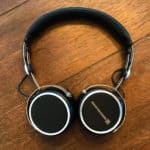
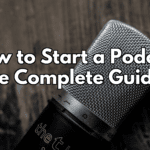






6 Comments
Pingback The 26 Best USB Mixers (for Podcasts and Home Studios) | Discover the Best Podcasts | Discover Pods
Pingback 30 of the Best Podcast Headphones | Discover the Best Podcasts | Discover Pods
Pingback Why Everyone Should Start a Podcast in 2021 | Discover the Best Podcasts | Discover Pods
Pingback The 10 Best Podcast Hosting Services (for new & experienced podcasters) | Discover the Best Podcasts | Discover Pods
Pingback How To Start A Podcast (The Complete Guide) | Discover the Best Podcasts | Discover Pods
Pingback Podcasting - Getting Started - Whys and Hows - Leo G Dion
Comments are closed.